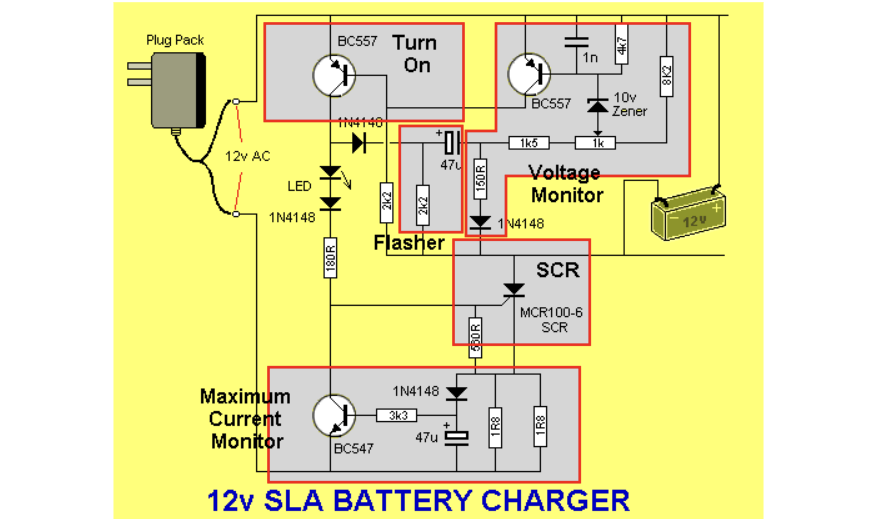How does a battery charger work in today’s tech-driven era? As vehicles and gadgets steer our daily lives, these chargers stand at the heart of modern innovation. Their nuanced functionality, often perceived as straightforward, is paramount in revitalizing our most cherished devices, from the intricate smartphones to powerhouse laptops. Journey with us as we navigate the intricate dynamics of battery charger technology.

Comprehensive guides
A battery charger, at its core, is a device that drives an electric current through a battery to recharge it. The energy conversion process is intricate, and several factors determine its efficiency.

The Basic Mechanism
All batteries work on the principle of moving electrons from one end to another. These two ends, termed as the anode and the cathode, allow the flow of electrons, which generates power. When a battery discharges, the process of electron movement occurs, and when it’s being charged, the process is reversed.
Battery chargers push an electric current against the flow of the discharge current. This restores the chemical differences in the battery and replenishes its energy storage capacity. To achieve this, the charger needs to provide a higher voltage than the battery to reverse the process of discharge.
Types of Chargers
Trickle Charger: This is a simple charger that works by supplying a constant DC or direct current power source to the battery being charged. It’s slow and is mostly used for maintaining the charge in batteries over a prolonged period.
Float Charger: It’s designed to maintain a battery at full charge. Once the battery reaches full charge, it reduces the voltage supply, ensuring the battery doesn’t overcharge.
Smart Charger: Incorporating microprocessors, these chargers can measure the battery’s state and adjust the charging actions accordingly. They can stop charging once the battery is full, preventing any potential damage from overcharging.
Fast Charger: These are designed to charge batteries in less time. However, they require a cooling mechanism, as they tend to heat up batteries during the charging process.
Factors Affecting Charging
Several factors can impact the charging process:
Battery Type: Not all batteries are the same. Lithium-ion, Nickel-Cadmium, or Lead-Acid, each type has its unique characteristics and requires specific charger types.
Temperature: Batteries are sensitive to temperature changes. Charging a battery in too cold or too hot conditions can affect its longevity and capacity.
Charge Rate: Pushing too much current too fast can heat up and damage the battery. A controlled and optimal charge rate ensures maximum battery life.
Age of the Battery: Over time, batteries lose their efficiency. An older battery will take longer to charge and might not hold the charge as effectively as a new one.
In conclusion, the world of battery chargers is vast and complex. However, understanding the basics gives insight into how these essential tools keep our daily devices running. So, the next time you plug in your phone or laptop to charge, you’ll have a better appreciation for the technology that powers it.
Working of a Battery Charger
Batteries transform chemical energy into electric energy. In contrast, chargers reverse this process by injecting electrons into the electrolyte, replenishing the chemical energy. Different electrolytes harness energy uniquely due to varying chemical reactions, electrode shapes/materials, etc. Thus, the charger must supply a specific current and voltage tailored to the particular battery type.
For instance, chargers for Lithium-Ion operate on a Constant Current Constant Voltage (CCCV) principle. They first provide a steady current until the cell achieves a designated topping voltage. The charger then maintains this voltage, allowing the current to naturally decrease until it hits a specified “end of charge” point. There’s an optional phase where the charger might send brief current bursts to offset self-discharge.
Chargers for Nickel-based batteries (like Ni-Cd and NiMH) sustain a Constant Current provided the voltage is still increasing and/or there isn’t a temperature surge (since charging absorbs ambient heat, the battery remains cool during this process). A fully charged Ni-Cd battery will exhibit a minor voltage decrease, whereas a Ni-MH battery’s voltage remains steady. However, the temperature increases in both. Advanced chargers monitor temperature and voltage changes to halt charging before any cell overheating occurs.
Chargers for Lead-Acid batteries (used in cars, motorboats, etc.) function similarly to those for Lithium-Ion. They have a bulk charge phase with a constant current, accounting for roughly three-quarters of the charge time. This is succeeded by a topping charge phase where the voltage stays constant while the current diminishes exponentially. Lastly, there’s a float charge, essentially counteracting self-discharge.
Selection of Battery Chargers
Chargers at their zenith operate with finesse, leveraging sophisticated microchip-driven circuits to gauge the charge stored in batteries. They determine the charging endpoint by monitoring nuances like shifts in battery voltage (referred to as delta V or ΔV) and cell temperature (delta T or ΔT). Once they discern that the charging is nearing completion, these savvy devices either cut off the current or transition to a minimal trickle charge. In essence, it’s virtually impossible to overcharge when using such an astute charger.
One cardinal principle of battery charging is the uniqueness of compatibility. Imagine trying to juice up your cellphone with a car battery charger—it’s absurd! Similarly, charging NiMH batteries with a Nickel Cadmium charger is a misstep. It’s pivotal to match your batteries with the appropriate charger. Always inspect the specified voltage and current needed by the batteries (typically indicated on the packaging or the batteries themselves). Ensure that your chosen charger aligns perfectly in terms of voltage, current, and the prescribed charging duration.
There are a few factors which need consideration while selecting a battery charger:
- An average car battery has a capacity of around 48 Amp hours which means that, fully charged, it delivers 1 amp for 48 hours, 2 amps for 24 hours, 8 amps for 6 hours and so on.
- A basic charger usually charges at around 2 amps – and so needs 24 hours to deliver the 48 amps needed to fully charge a flat, 48 Amp hour battery.
- But there is a wide range of chargers with different charge rates on the market – from 2 to 10 amps. The higher the charge output, the faster a flat battery is recharged. Fast charging, however, is undesirable as it can buckle the battery plates.
- A basic home battery charger incorporates a transformer and rectifier, to change the mains 110/220 volt alternating current to 12 volt direct current , and allows the
You may like: automotive battery charger.
FAQs
What is the basic principle behind a battery
ic current through it. The charger essentially reverses the chemical reaction in the battery, converting electrical energy to stored chemical energy.
Do all battery chargers work the same way?
No, there are various types of battery chargers, including trickle chargers, smart chargers, and fast chargers. They differ in their charging speeds, mechanisms, and suitability for different battery types.
How do smart chargers differ from traditional chargers?
Smart chargers can adapt their charging output based on the battery’s current state. They typically use microprocessors to monitor the battery’s voltage, temperature, and/or charge state to optimize charging speed, efficiency, and safety. This can prolong battery life and reduce the risk of overcharging.
Is it safe to leave a battery in the charger after it’s fully charged?
It depends on the charger and battery type. Some older chargers might overcharge batteries if left connected for too long. However, modern smart chargers usually switch to a maintenance mode once the battery is fully charged, making it safer to leave the battery connected. Always refer to the manufacturer’s guidelines to ensure safety.
Can I use one charger for different types of batteries?
Not always. Different battery chemistries (like NiMH, Li-ion, and Lead Acid) have distinct charging requirements. Using the wrong charger can damage the battery or reduce its lifespan. Always ensure the charger is compatible with the battery type you intend to charge.
How does a battery charger work simple?
A simple charger works by supplying a constant DC or pulsed DC power source to a battery being charged. A simple charger typically does not alter its output based on charging time or the charge on the battery. This simplicity means that a simple charger is inexpensive, but there are tradeoffs.
How does a charger recharge a battery?
During charging, the battery functions as an electrolytic cell. When the cell is connected to an outside energy source, the electrons in the cathode are forced to flow back to the anode. There is movement of electrons from an external power source to the anode. On the other side, electrons are removed from the cathode.
What is the difference between a battery charger and a battery?
In a nutshell, a battery maintainer is used to keep a battery charged over a long period of time. A battery charger is used to charge a dead or completely discharged battery. A battery charger uses high current, whereas a battery maintainer uses low current to charge and maintain the battery.
Do battery chargers charge all batteries?
What type and size of batteries can be recharged? Most battery chargers will charge AA and AAA sized rechargeable batteries regardless of whether they are Intelligent or Manual chargers. Some will also charge 9 volt batteries – but be aware that the charging times for 9 volt batteries will be much longer in comparison.
How many times can a battery be recharged?
When shopping for rechargeable batteries, there are a couple of key things to remember. First, rechargeables have a shelf life of about 5 years and can be recharged roughly 500–1,000 times, depending on brand and usage.
Conclusion
Battery chargers are pivotal in ensuring our daily devices remain powered. These chargers, grounded in the principle of driving electric currents to reverse battery discharges, vary in types, including trickle, float, smart, and fast chargers. The efficiency of charging is influenced by various factors like battery type, temperature, charge rate, and the battery’s age.
Not all chargers suit every battery, emphasizing the need to match the charger with the respective battery type for optimal performance. Rechargeable batteries can last up to 5 years and be charged between 500 to 1,000 times. Thus, when using battery chargers, it’s essential to understand their mechanics and select the appropriate type for safety and efficiency.

Originating from Detroit, Michigan, Byron Moss boasts over two decades of specialized expertise in the realm of automotive battery charger design. With a foundation laid by a Mechanical Engineering degree from the University of Michigan, Byron’s professional trajectory has predominantly revolved around advancing battery charger technology. At General Motors, he introduced groundbreaking charger innovations ensuring faster, more efficient charging cycles. His stint at Tesla saw him revolutionizing charger designs for electric vehicles, ensuring optimal battery life and minimized charging times. One of his standout achievements includes a patented fast-charging system that has become an industry standard. A torchbearer for progress, Byron’s name is synonymous with excellence in battery charger design in the automotive arena.


Schumacher covers all my charging needs, great product.
The Schumacher battery charger offers an optimal power supply, ensuring a consistent voltage during flashing and programming. I love its adjustable voltage feature. After researching on Amazon, I discovered just how great Schumacher is. I would definitely suggest Schumacher to all!
I would happily recommend this Schumacher charger to anyone. It fulfills its intended purpose, and I am very pleased with it. The delivery was quick, and the quality is excellent.